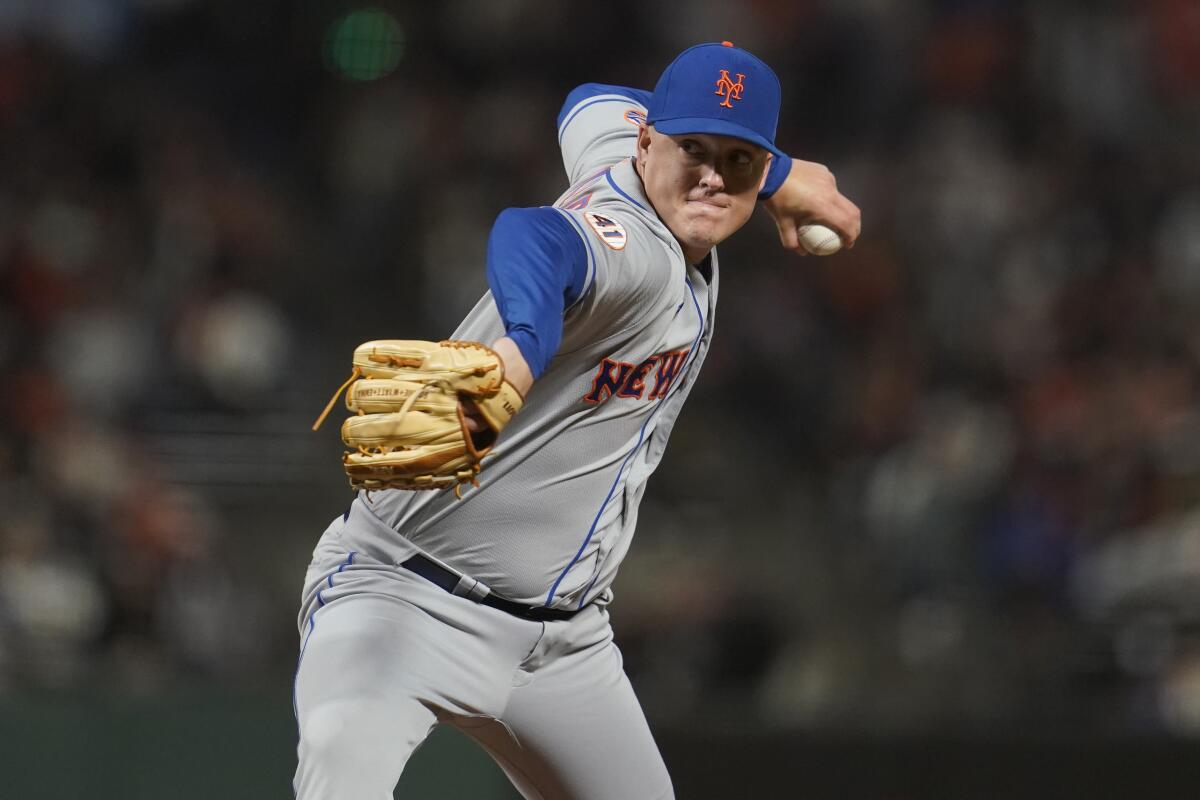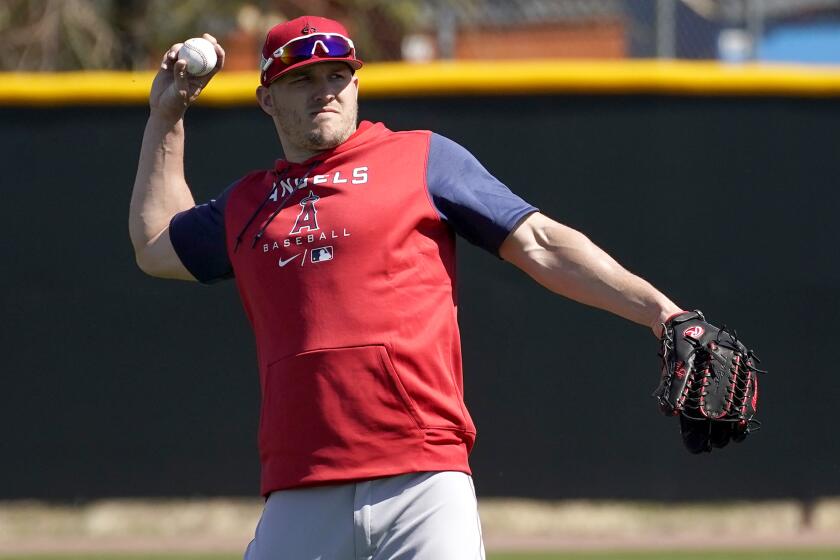Angels hope Aaron Loup’s addition to bullpen results in zero-sum game

- Share via
TEMPE, Ariz. — Aaron Loup marvels at his numbers with the New York Mets last season, so much so that the new Angels left-hander still is scratching his head six months after becoming only the fifth reliever in the last 10 years — and 12th since 1950 — to throw 50 innings or more with an earned-run average of less than 1.00.
“It’s crazy,” said Loup, who will play a key short-relief role for the Angels after signing a two-year, $17-million deal in November. “A lot of things have to go right for that to happen. I have to pitch well, but at the same time, when you leave a game with guys on base, the guys coming in after you have to help out.
“It’s not just me — it was everybody, especially the guys playing defense behind me, because I strike guys out, but I’m not a strikeout pitcher. I pitch to contact most of the time. I’m trying to get in and out of there in 10 pitches or less.”
Loup, 34, does not have the overpowering repertoire usually associated with a sub-1.00 ERA. The hardest pitch he throws out of his low-three-quarters arm slot is a two-seam sinking fastball that averaged 92.4 mph last season, a pitch he complements with an 84.7-mph cut fastball, 79.9-mph changeup and 75.6-mph curve.
The other four relievers with sub-1.00 ERAs in the last decade were hard-throwing closers or primary setup men — Blake Treinen (0.78 in 80-1/3 innings with Oakland in 2018), Zack Britton (0.54 in 67 innings with Baltimore in 2016), Wade Davis (0.94 in 67-1/3 innings with Kansas City in 2015) and Fernando Rodney (0.60 in 74-2/3 innings with Tampa Bay in 2012).
Yet, there was Loup with a zero in front of his ERA and zero saves last year, the 10-year veteran going 6-0 with a 0.95 ERA in 65 games, striking out 57 and walking 16 in 56-2/3 innings and limiting opposing hitters to a .192 average and .501 on-base-plus-slugging percentage.
“Maybe the [velocity] number on the board doesn’t really compute, but everything else does,” Angels manager Joe Maddon said. “I think this is where [analytics] shine — they give you the ability to explain why he’s as good as he is and understand why hitters have such a difficult time against him.
“I think that’s why you’re seeing other guys becoming more successful that maybe were nice pitchers but all of a sudden are viewed differently, because they were able to receive information that doesn’t necessarily change a pitch they’re throwing, but maybe the frequency of it and the location of it benefits them.”
A day after Angels manager Joe Maddon said it was possible Mike Trout could move to left field, the subject was closed — Trout is staying in center.
Loup acknowledges that his 2020 season with the Rays, who have been at the forefront of the analytics revolution, played a key role in his development, but so did his mastery of a relatively new pitch, a healthy elbow and a renewed confidence.
Loup, who grew up in Raceland, La., and played college ball at Tulane, was effective with a three-pitch mix in his first seven seasons with Toronto, going 12-20 with a 3.47 ERA in 369 games from 2012-18.
In 2017, on the advice of then-Blue Jays bullpen coach Dane Johnson, he began throwing a cutter, a pitch that breaks left to right and paired well with his sinking fastball, which breaks right to left.
“He’d been wanting me to try it for a while, and for whatever reason I was reluctant, but I did it, and it changed my career,” Loup said. “I have that good two-seamer, sinker, and now I have a similar pitch that holds that same lane but goes in the opposite direction.”
Loup signed with San Diego in 2019 but pitched in only four games before suffering a flexor strain and undergoing season-ending surgery.
He signed a minor league deal with the Rays in 2020 and went 3-2 with a 2.52 ERA in 24 games of the pandemic-shortened season. He had a 3.38 ERA in nine playoff games, including four World Series appearances against the Dodgers.

“A big part of that was being healthy, but prior to that, I had never been exposed to the whole analytic side,” Loup said. “I always had an idea in my head how my stuff played and how I should use it, but being able to go there and actually see it and how to better apply it, you kind of grasp and understand what’s going on.
“It was like, if I’m facing a right-handed hitter and I throw two sinkers in, all of a sudden I can throw that cutter off the same lane, and you think you’re getting the sinker, and all of a sudden it goes the other way. They showed me different things to make you more efficient and use your repertoire better.”
Loup carried that approach to New York, where he credited Mets catchers James McCann and Tomas Nido with helping him mix pitches to become even more unpredictable and encouraging him to attack the zone with strike one.
An attitude adjustment after Loup’s first game of the season, in which he yielded a single, a hit batter, two unearned runs and blew a save in a 5-3 loss to the Phillies on April 5, also helped.
“I went home after that night and I realized, you’ve pitched in all these situations, and you know what you need to do to get out of these situations and pitch well,” Loup said. “The confidence boost kind of triggered in me.”
Loup thrived in traffic, holding batters to a .183 average (17 for 93) with men on base, a .183 mark (11 for 60) with runners in scoring position and a .125 average (two for 16) with the bases loaded.
“I seem to pitch better when my back is against the wall and there’s no room for error,” Loup said. “It tends to bring out the best in me, for whatever reason.”
Though his track record and experience might warrant a traditional setup role in front of Angels closer Raisel Iglesias, Loup is expected to pitch anywhere from the fifth through ninth innings, joining newly acquired right-handers Ryan Tepera and Archie Bradley in what is expected to be a much-improved bullpen.
Relief pitcher Ty Buttrey walked away from baseball last spring, but he returns to the Angels refreshed and ready to be an asset in the bullpen.
“I like the concept of a middle-inning closer, when you’re able to shut games down in the middle innings,” Maddon said. “This guy just wants to pitch. He doesn’t care when it is.”
Loup made that clear in a meeting with Maddon, pitching coach Matt Wise and general manager Perry Minasian at the beginning of camp.
“I told them I don’t need a role,” Loup said. “If you need me to throw the fifth, the ninth, I don’t care. I just want to pitch, to compete. I enjoy being the guy who you go to when things go sideways and you’re not real sure what to do and you need to hit the panic button.”
More to Read
Go beyond the scoreboard
Get the latest on L.A.'s teams in the daily Sports Report newsletter.
You may occasionally receive promotional content from the Los Angeles Times.









